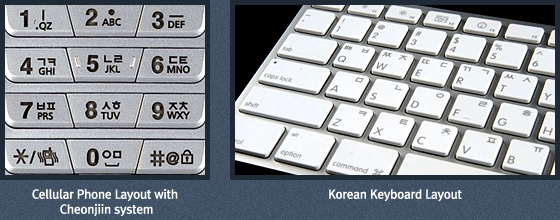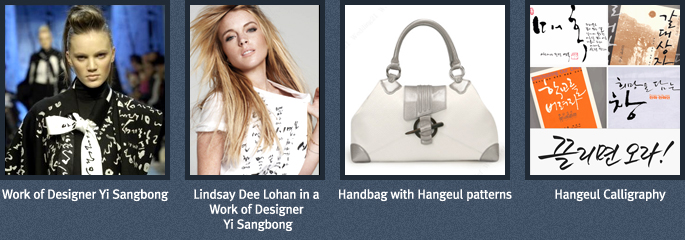|
|
|
|
|
|
|
| |
 |
According the 2007-2008 report on the world information technology ranking released by the World Economy Forum, the Republic of Korea came into the 9th place among 127 countries of the world. It is already a well-known fact that Korea is the IT power in the world. People from all over the world use cell phones made by Korean companies and the world's famous IT companies are scrambling for launching their new products in Korea. But are you aware of the fact that Hangeul plays an important role in this IT-oriented era?
In IT era, rapid and exact data-processing is important. Hangeul ideally corresponds to this. Therefore, Hangeul is appraised as the most suitable alphabet for the digital age. When Hangeul is used on a computer, its efficiency is incomparable to other languages. Its character system, consisting of consonant(s) and vowel(s) are bound to make one letter and when typing letters, consonant(s) and vowel(s) are entered alternately, displaying rhythmical sense and boosting its efficiency. Furthermore, differentiated from Chinese characters and Japanese Kana which deal with data with the help of other characters like Roman alphabets, Hangeul is faster in processing information since it directly deals with data with only 24 alphabets. This strong point of Hangeul became even stronger in mobile apparatuses where intense efficiency is needed. The representative Hangeul entering system, Cheonjiin system can manage all vowels only with 3 vowel keys (ㆍ , ㅡ , l ) and the stroke-adding principle of Hangeul, that makes 'ㄲ', 'ㅋ' on a basis of 'ㄱ', enables 3 consonants to be entered using only one key. This Hangeul entering system is about 35% faster in entering one letter, compared to entering one English letter.
Koreans are blessed to have Hangeul in the IT era. They are taking full advantage of the merits that Hangeul brings to places such as workplaces, schools and other places even now, painting a rosy picture for Korean IT business in future.
|
| |
 |
| |
 |
At the Pret-A-Porter fashion show in Paris, February 2006, a famous Korean designer Yi Sangbong laid out his works on Hangeul motif and attracted attention in the fashion scene. The designer thought Hangeul as the Korean beauty and applied it to his works' motif. Though this was not the first time Hangeul became a theme in culture and art, Hangeul started to lure more attention in these areas as the value of Hangeul as a design commenced to shine its idiosyncrasy. The advent of calligraphy penetrated into our lives, offering us opportunities to become familiar with the language we use everyday. Calligraphy refers to the beautiful font, which conveys the beauty of Hangeul to the general public the most intimately through movie titles, posters, music albums, book covers and ad designs. Typography, the printing type design, as well as calligraphy are the means to express the beauty of Hangeul in printing.
The aforementioned fashion scene cannot be missed. On every Hangeul Day, a Hangeul t-shirt design competition is held and beautiful garments with Hangeul prints are introduced, drawing people’s attention and being loved by many. A design corporation that has been producing quality fashion accessories with Hangeul patterns such as neckties, scarves and belts for more than 10 years, got a space in a famous domestic department store and is competing with the world famous brand products. Hangeul is also expressed in dancing, used as a motif in modern dance works, praised at home and abroad. Furthermore, it is expressed in other art fields like installations, ceramic art, sculptures, Western paintings and prints and is earning a good reputation.
Now, the value of Hangeul is also gaining recognition for its beauty beyond its amazing linguistic functions. Designers and artists in various fields are continuously studying and experimenting the potentialities of Hangeul in culture and art scene. At this very moment, the beauty of Hangeul is evolving.
|
| |
 |
| |
 |
In the mid-1990s, as Korean television soap operas were exported to many Asian countries including China and Japan, Asians commenced to show their interest in Korean culture. The term 'Hallyu' or the Korean wave, was first used when the Chinese reporters depicted it as the enthusiasm for Korean pop culture in China and now, the preference of Korean culture to the foreigners is penetrating into other sectors such as Korean products and the Korean language.
The foreigners' enthusiasm for the Korean language can be surely confirmed by taking a look at the development of increase in the number of applicants for TOPIK, Test of Proficiency in Korean. The first TOPIK was held for the 2,692 applicants at 14 spots in 4 countries in the year of 1997 and for total 31,230 applicants at 73 spots in about 28 countries in the 10th TOPIK, 2006.
The management organizations for testing decided to hold the annual test twice a year from 2007, according to the rapid increase of the number of applicants.
The foreigners’ enthusiasm for the Korean language can be surely confirmed by an increase in the number of applicants for Test of Proficiency in Korean or TOPIK. The first TOPIK taken by 2,692 applicants at 14 places in 4 countries was held in 1997. The figure rose to 31,230 applicants taking the exam at 73 places in about 28 countries in the 10th TOPIK in 2006. The increase led the TOPIK organization to hold the test twice a year from 2007.
Now, let’s take a look at the Hangeul fever by countries. China where the term ‘Hallyu’ was first used is ranked first in the number of applicants for TOPIK, Chinese government-run educational broadcasting station, CETV started to broadcast in Korean as a foreign language educational program following English. Junior and senior students in high schools as well as universities in China offered Korean lectures. Japan is also heated with the Korean language fervor. Japanese educational authorities included Korean in college entrance examination and more than 300 universities in Japan opened Korean lecture. Korean wave in Mongolia cannot be missed. In Ulan Bator, the capital city of Mongolia, ‘Hangeul Day Festival in Mongolia’ was held in success in October, 2006 with more than 1,500 participants. The Department of Korean language was officially established in the National University of Mongolia. Later, Korean lectures were provided in Mongolia National University of Foreign Languages and University of Ulan Bator. In addition, the interest in Korea raised by the Korean pop culture is spreading vigorously in Asian countries including Vietnam, Myanmar and Thailand. The popularity of learning Korean started for the purpose of understanding Korean movies and soap operas and to sing along the Korean pop songs has now become a cultural icon for the Asians trying to make a foray into Korean companies and understand the Korean culture.
Even if preference towards a nation’s culture has led to the interest in language, the Korean language has not received as much spotlight as the Chinese characters and Japanese Kana regardless of its linguistic excellence.
Thus, Korean should know Hangeul in depth and adopt correct linguistic knowledge to promote Hangeul worldwide.
|
| |
 |
|
|
|
|
